Abstract
OBJECTIVES. Several advisory committees have recently recommended that alcohol consumption be limited to moderate levels. Moderate drinking has been defined generally as not more than two drinks per day for healthy men and not more than one drink per day for healthy, nonpregnant women. The impact of reducing alcohol consumption to within the recommended guidelines on the prevalence of two serious alcohol-related problems was examined by modeling the relationship between average daily ethanol intake and alcohol abuse and dependence. METHODS. The recommended drinking guidelines, both in their existing form and modified by a measure of impairment, were applied to the observed distribution of consumption derived from a large representative survey of the US general population. RESULTS. The results demonstrated that restricting drinking to the maximum allowable levels under the existing and the modified guidelines would reduce the prevalence of alcohol abuse and dependence by 14.2% and 47.1%, respectively, in the adult US general population. CONCLUSIONS. Implications of these findings are discussed in terms of the validity of the assumptions underlying the models and the nature and direction of future research that would form the basis of newly developed guidelines for safe drinking limits.
Full text
PDF
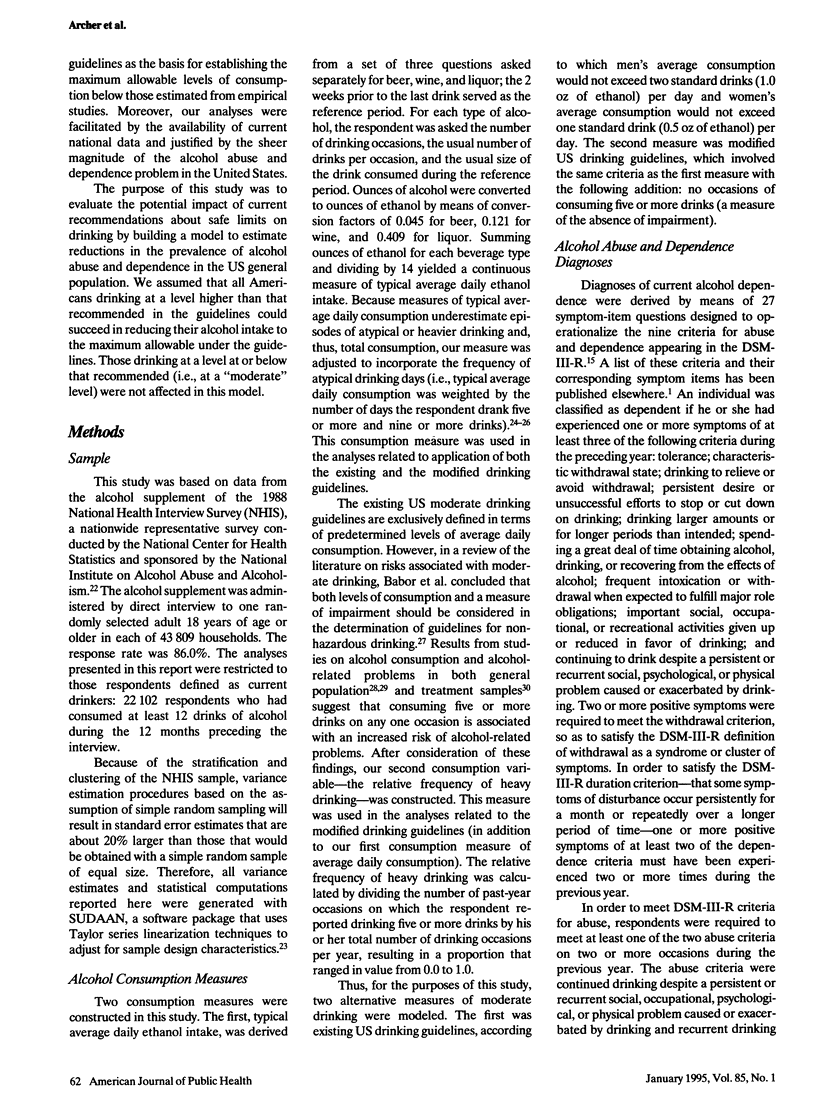
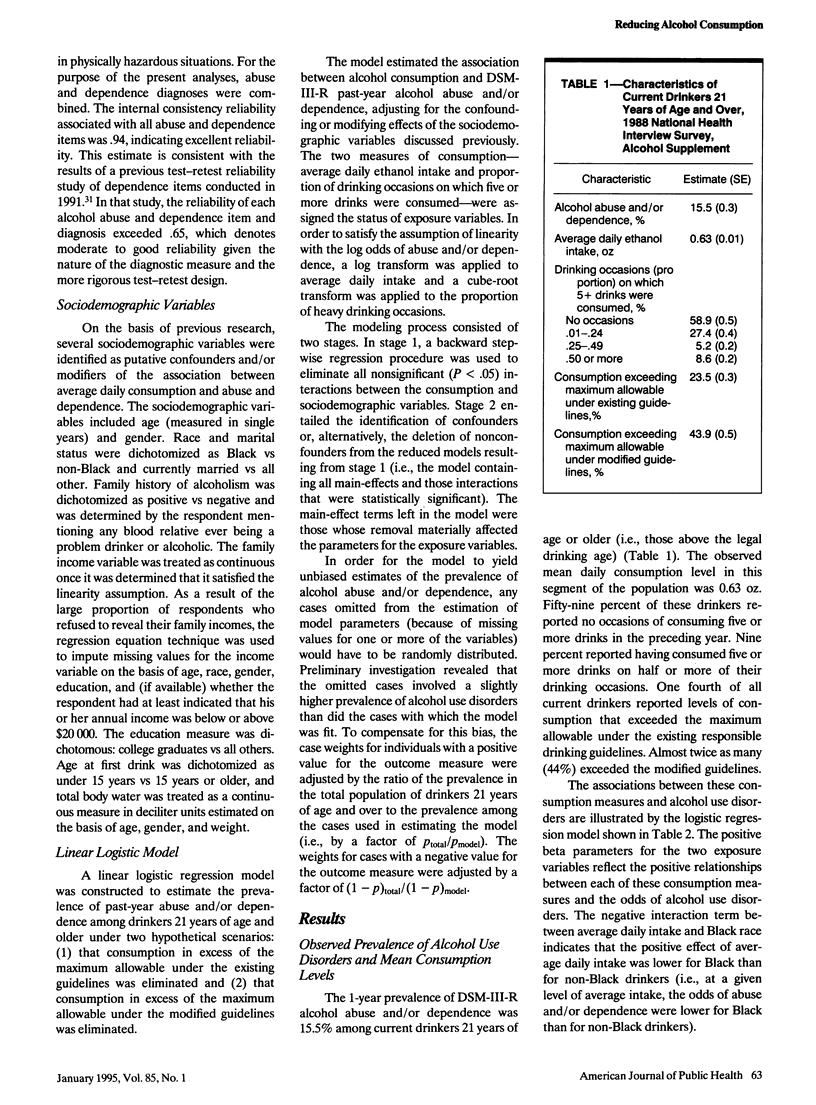
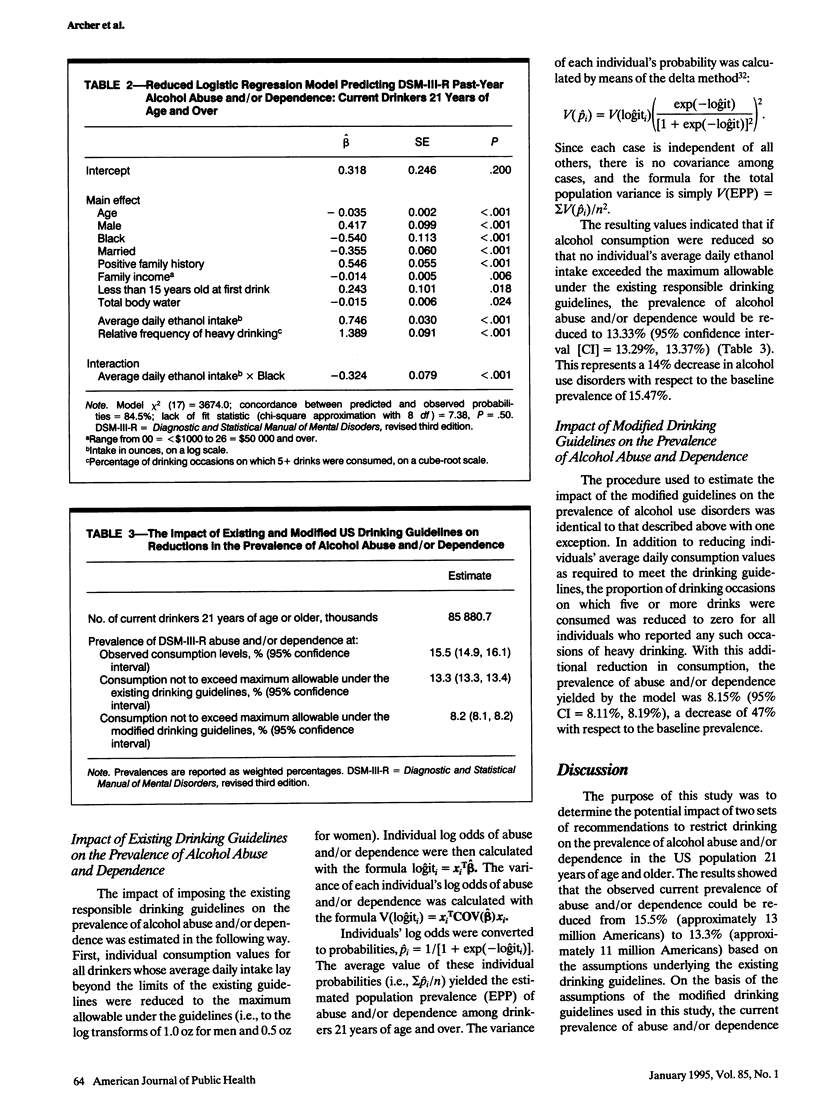
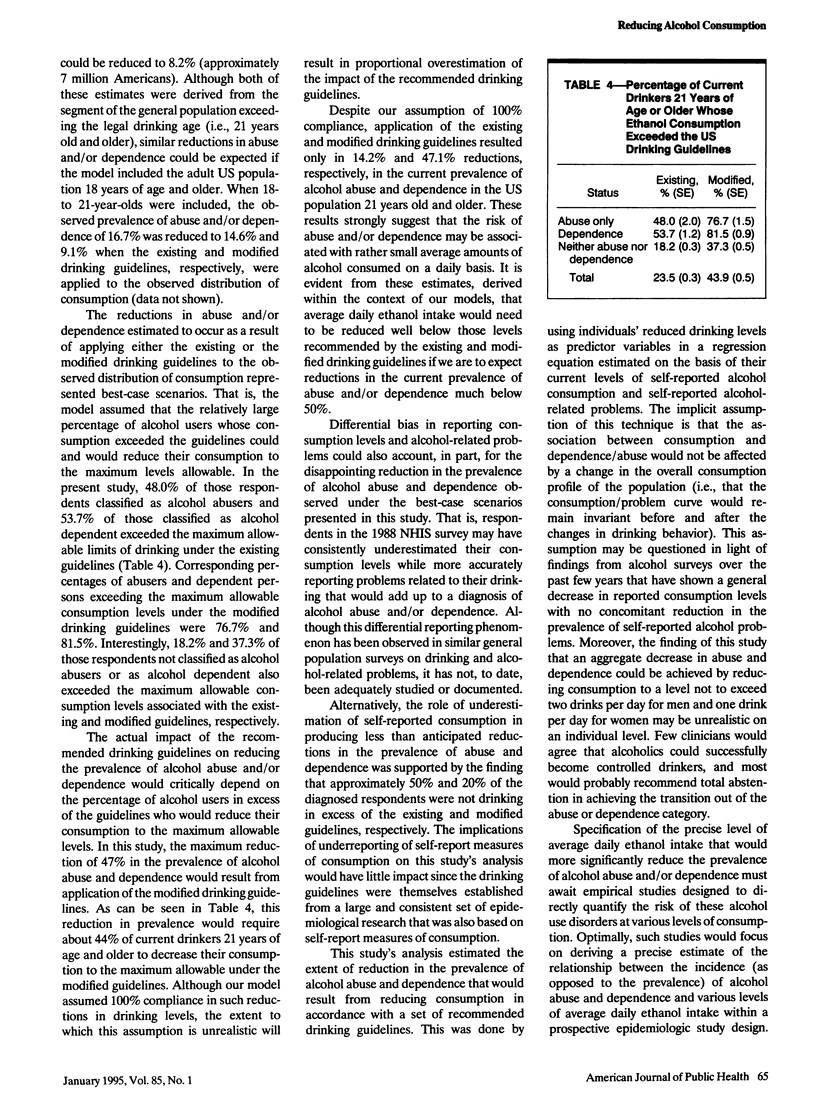
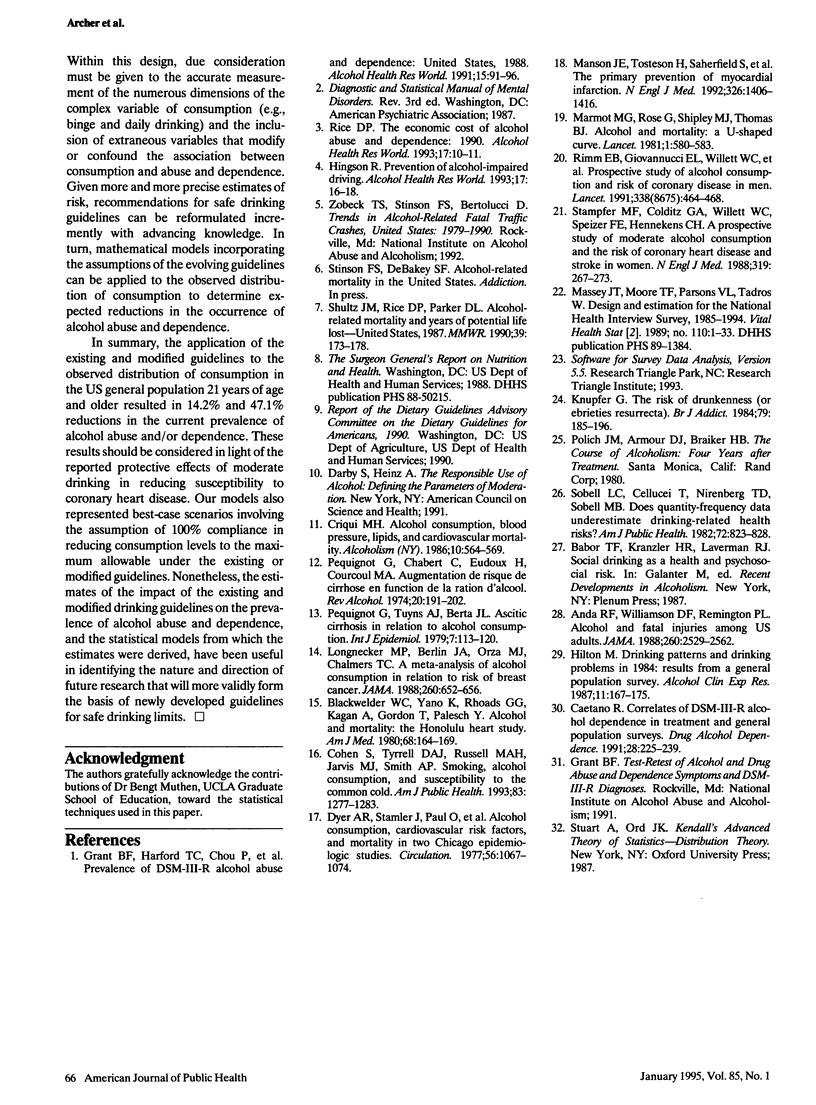
Selected References
These references are in PubMed. This may not be the complete list of references from this article.
- Anda R. F., Williamson D. F., Remington P. L. Alcohol and fatal injuries among US adults. Findings from the NHANES I Epidemiologic Follow-up Study. JAMA. 1988 Nov 4;260(17):2529–2532. [PubMed] [Google Scholar]
- Blackwelder W. C., Yano K., Rhoads G. G., Kagan A., Gordon T., Palesch Y. Alcohol and mortality: the Honolulu Heart Study. Am J Med. 1980 Feb;68(2):164–169. doi: 10.1016/0002-9343(80)90350-2. [DOI] [PubMed] [Google Scholar]
- Caetano R. Correlates of DSM-III-R alcohol dependence in treatment and general populations. Drug Alcohol Depend. 1991 Oct;28(3):225–239. doi: 10.1016/0376-8716(91)90056-5. [DOI] [PubMed] [Google Scholar]
- Cohen S., Tyrrell D. A., Russell M. A., Jarvis M. J., Smith A. P. Smoking, alcohol consumption, and susceptibility to the common cold. Am J Public Health. 1993 Sep;83(9):1277–1283. doi: 10.2105/ajph.83.9.1277. [DOI] [PMC free article] [PubMed] [Google Scholar]
- Criqui M. H. Alcohol consumption, blood pressure, lipids, and cardiovascular mortality. Alcohol Clin Exp Res. 1986 Dec;10(6):564–569. doi: 10.1111/j.1530-0277.1986.tb05145.x. [DOI] [PubMed] [Google Scholar]
- Dyer A. R., Stamler J., Paul O., Berkson D. M., Lepper M. H., McKean H., Shekelle R. B., Lindberg H. A., Garside D. Alcohol consumption, cardiovascular risk factors, and mortality in two Chicago epidemiologic studies. Circulation. 1977 Dec;56(6):1067–1074. doi: 10.1161/01.cir.56.6.1067. [DOI] [PubMed] [Google Scholar]
- Hilton M. E. Drinking patterns and drinking problems in 1984: results from a general population survey. Alcohol Clin Exp Res. 1987 Apr;11(2):167–175. doi: 10.1111/j.1530-0277.1987.tb01283.x. [DOI] [PubMed] [Google Scholar]
- Knupfer G. The risks of drunkenness (or, ebrietas resurrecta). A comparison of frequent intoxication indices and of population sub-groups as to problem risks. Br J Addict. 1984 Jun;79(2):185–196. doi: 10.1111/j.1360-0443.1984.tb00261.x. [DOI] [PubMed] [Google Scholar]
- Longnecker M. P., Berlin J. A., Orza M. J., Chalmers T. C. A meta-analysis of alcohol consumption in relation to risk of breast cancer. JAMA. 1988 Aug 5;260(5):652–656. [PubMed] [Google Scholar]
- Manson J. E., Tosteson H., Ridker P. M., Satterfield S., Hebert P., O'Connor G. T., Buring J. E., Hennekens C. H. The primary prevention of myocardial infarction. N Engl J Med. 1992 May 21;326(21):1406–1416. doi: 10.1056/NEJM199205213262107. [DOI] [PubMed] [Google Scholar]
- Marmot M. G., Rose G., Shipley M. J., Thomas B. J. Alcohol and mortality: a U-shaped curve. Lancet. 1981 Mar 14;1(8220 Pt 1):580–583. doi: 10.1016/s0140-6736(81)92032-8. [DOI] [PubMed] [Google Scholar]
- Pequignot G., Tuyns A. J., Berta J. L. Ascitic cirrhosis in relation to alcohol consumption. Int J Epidemiol. 1978 Jun;7(2):113–120. doi: 10.1093/ije/7.2.113. [DOI] [PubMed] [Google Scholar]
- Rimm E. B., Giovannucci E. L., Willett W. C., Colditz G. A., Ascherio A., Rosner B., Stampfer M. J. Prospective study of alcohol consumption and risk of coronary disease in men. Lancet. 1991 Aug 24;338(8765):464–468. doi: 10.1016/0140-6736(91)90542-w. [DOI] [PubMed] [Google Scholar]
- Sobell L. C., Cellucci T., Nirenberg T. D., Sobell M. B. Do quantity-frequency data underestimate drinking-related health risks? Am J Public Health. 1982 Aug;72(8):823–828. doi: 10.2105/ajph.72.8.823. [DOI] [PMC free article] [PubMed] [Google Scholar]
- Stampfer M. J., Colditz G. A., Willett W. C., Speizer F. E., Hennekens C. H. A prospective study of moderate alcohol consumption and the risk of coronary disease and stroke in women. N Engl J Med. 1988 Aug 4;319(5):267–273. doi: 10.1056/NEJM198808043190503. [DOI] [PubMed] [Google Scholar]


